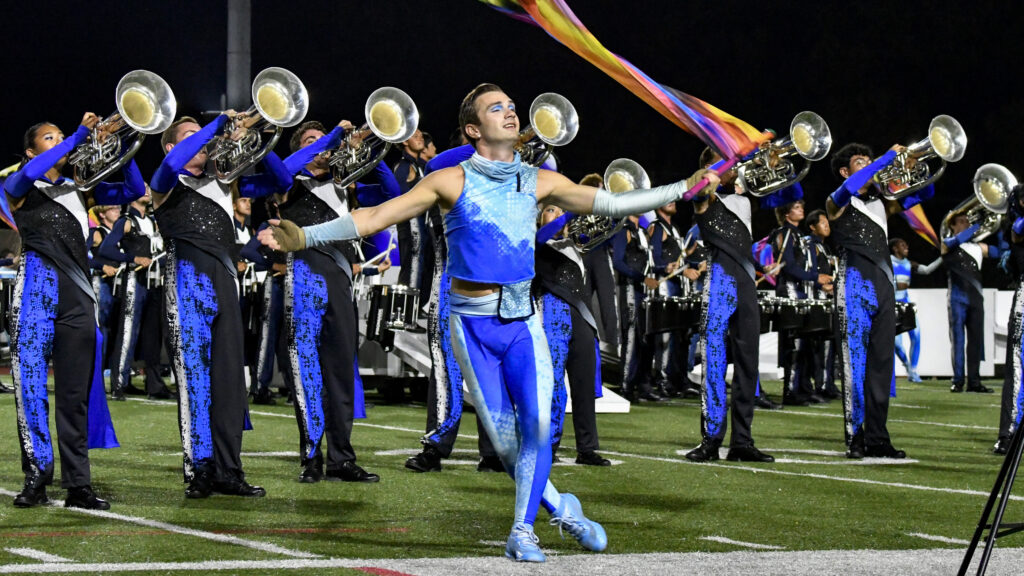In 2012, Blue Devils earned the corps’ 15th World Championship title at the conclusion of Drum Corps International’s 40th anniversary season.
Crossmen, who hadn’t advanced into Finals since 2004, ended Blue Stars’ four-year Finals streak by three tenths of a point in Semifinals.
While the Devils’ win was impressive, Carolina Crown walked off the field in second place with the caption award for best brass performance, also tying Blue Devils or best visual performance. Phantom Regiment earned its first medalist finish since 2008, finishing in third place with music entirely from the Puccini opera, “Turandot.”

An unusual programming choice for a drum corps that would perform only in the summer months, The Cadets’ Christmas holiday-themed “12.25” was like opening one present after another.
Setting a wintry theme from the get-go, drill forms of the world’s largest snowflakes fell from the sky but didn’t stick around for long as others quickly moved in. The gift opening started with a recitation by British actor Stephen Fry of the first line of the poem, “A Visit from St. Nicholas,” more commonly known as “The Night Before Christmas.”
During the recitation of that first line of the poem, the color guard members, who were attired in costumes suggestive of gift-wrapping of various bright colors, formed a tight block at the center of the field and served as the hub of a giant snowflake made up by the rest of the corps. Six large stage sets made to look like wrapped Christmas presents were positioned in the upper left of the field and a wall depicting Christmas tree decorations was spread out across the front sideline to help put fans into the holiday spirit even if a few months early.

The sound of sleigh bells led into “Carol of the Bells,” which Ukrainian composer Mykola Leontovych wrote in 1914, based on the Ukrainian folk tune, “Shchedrk (The Little Swallow.)” The folk tune was simply those four notes repeated over and over, and in this form was not a Christmas carol. What turned it into the popular carol we now know include the lyrics added in 1936 by fellow Ukrainian Peter J. Wilhousky, an arranger for Arturo Toscanini’s NBC Symphony Orchestra. That ensemble performed weekly radio concerts and was the house orchestra for the NBC network in the early days of television.
Two trumpeters to the outside of each of the 40-yard lines played the recurring 4-note figure into microphones, adding a sense of hearing the notes reverberate through a shopping mall. The color guard members picked up reflective silver flags at this point and spun in the block form of a Christmas tree, followed by the joyous pealing of church bells leading into a different snowflake form.
Over the season, new Christmas tunes were added atop the “Carol of the Bells” melody, including “What Child is This?” “Greensleaves,” “God Rest Ye Merry, Gentlemen,” and “Sing We Now of Christmas,” as various horn sections turned around at 208 beats-per-minute to play those melodies toward the audience.

The second production of the show was “Jingle Bells,” based on the version recorded by the Imani Winds, a contemporary classical chamber wind quintet based in New York City. The famous melody, one of the best-known American songs throughout the world, originally was to be sung during the Thanksgiving season. It became best associated with Christmas in the late 1800s after appearing in a number of songbooks, and was further popularized in 1889 as one of the very first recordings produced for the new Edison phonograph cylinder, the wax cylinders that preceded phonographic discs.
After a recording of Lucy from the classic animated television special “A Charlie Brown Christmas” complained about the commercialism of the holiday, the corps created a gigantic form of a bell and then pivoted it to give the impression of the bell ringing. The guard members spun and tossed Christmas presents and the brass players marched into another block Christmas tree formation, with reflective golden flags serving as sparkling lights.
Primarily a percussion feature during its second half, “Jingle Bells” captured the joy of children playing with the decorated boxes of their presents, concluding with a rock-out statement complete with screaming trumpets and a jazzy swing segment that segued into the reverential strains of the next carol.

“Do You Hear What I Hear?” was written in late 1962 as a plea for peace in response to the terrifying unease of that October’s Cuban Missile Crisis. The husband-wife team of composer Noël Regney and lyricist Gloria Shanye Baker wrote the song, but reversed their normal roles, with Regney writing the lyrics to Baker’s melody. The Harry Simeone Chorale made the first recording just a few years after popularizing “The Little Drummer Boy,” but the song really took off after Bing Crosby recorded it in 1963.
At this point in the production, segments of the Christmas gift stage sets in the upper left of the field were pulled apart to create a series of ramps that color guard members slid down as if riding toboggans. An image of a soaring church steeple appeared as the brass section sweetly played the solemn melody.
The final Christmas offering was “Hark! The Herald Angels Sing,” which first appeared in a hymnbook in 1739 to lyrics by Charles Wesley, a prolific writer of more than 6,000 church hymns and brother of John Wesley, regarded as a founder of the Methodist movement and the inspiration for the religious denomination that bears his name. Decades later, famed composer Felix Mendelssohn wrote the tune to which the lyrics are now sung. The tune was preceded by the sounds of “O Tannenbaum (O Christmas Tree),” proclaimed through the bells of four trumpeters.

Additional voice-overs were then heard from the 1965 television special, “A Charlie Brown Christmas,” and Boris Karloff reading from the 1966 original animated version of “How the Grinch Stole Christmas.” Later, Buddy (Will Ferrell) from the 2003 film “Elf” and Rudolf from the 1964 animated film, “Rudolf, the Red-Nosed Reindeer,” also chimed in.
Finally, the lyrics, “In Excelsis Deo,” accompanied a lone color guard member who spread a large white arced silk as if angel wings, an effect brought back from the corps’ championship “Angels and Demons” show of the year before. After a company front moved forward, the horns spelled out “12.25” across the field as church bells rang gloriously.
Further underscoring the religious aspects of the holiday season, the brass players marched into a diadem (crown) that transitioned into an ichthus, the open form of a fish that became an early Christian symbol.
A hint of “Joy to the World” was heard leading into the final company front push that brought the show to a rousing conclusion that implied it was now okay for all to unwrap their presents.

Michael Boo was a member of the Cavaliers from 1975-1977. He has written about the drum corps activity for more than 35 years and serves as a staff writer for various Drum Corps International projects. Boo has written for numerous other publications and has published an honors-winning book on the history of figure skating. As an accomplished composer, Boo holds a bachelor's degree in music education and a master's degree in music theory and composition. He resides in Chesterton, Indiana.





